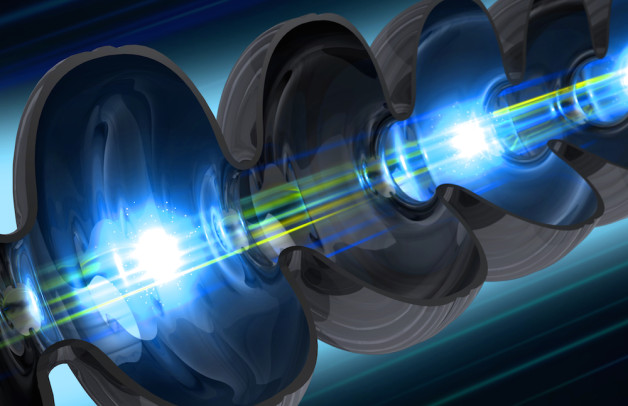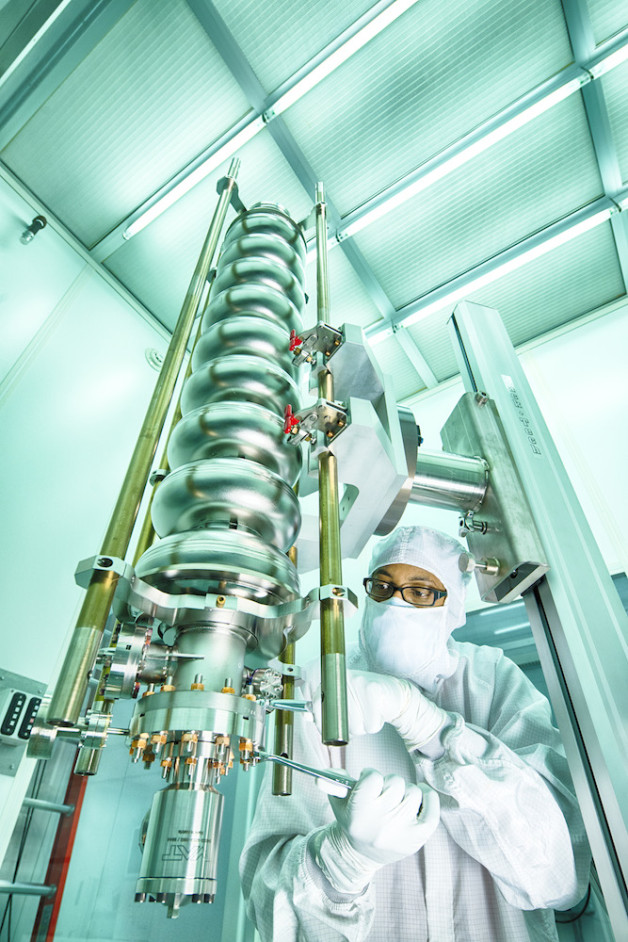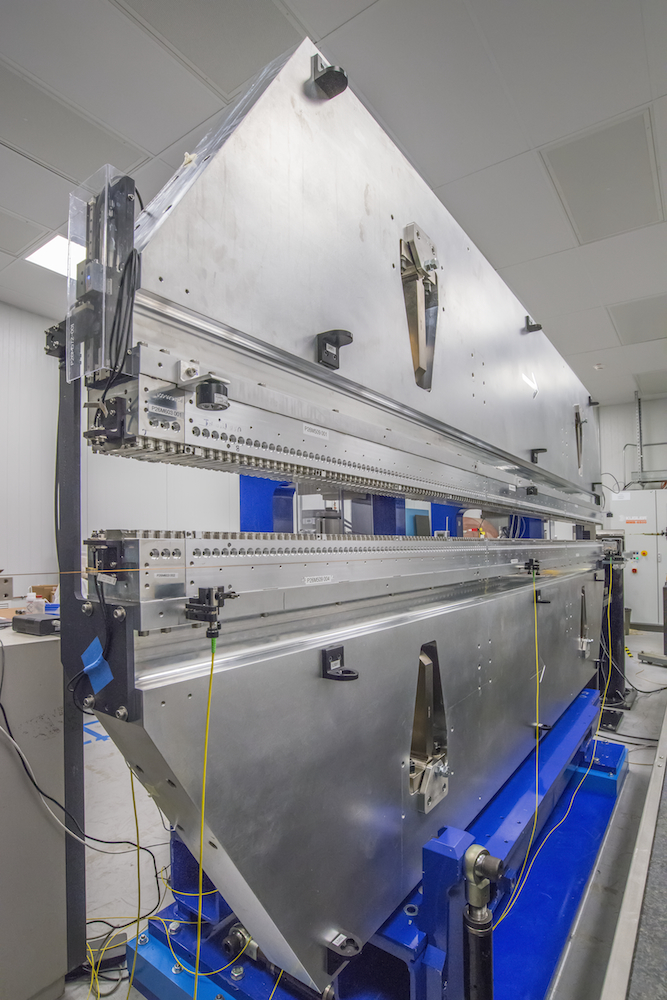
An electron beam travels through a niobium cavity, a key component of a future LCLS-II X-ray laser, in this illustration. Kept at minus 456 degrees Fahrenheit, these cavities will power a highly energetic electron beam that will create up to 1 million X-ray flashes per second. (Credit: SLAC National Accelerator Laboratory)
Construction begins today on a major upgrade to a unique X-ray laser that will add a second X-ray laser beam that’s 10,000 times brighter, on average, than the first one and fires 8,000 times faster—up to a million pulses per second.
Researchers at the Department of Energy’s Lawrence Berkeley National Laboratory (Berkeley Lab) are contributing key components for the project, known as LCLS-II, that will greatly increase the power and capacity of the Linac Coherent Light Source (LCLS), a free-electron X-ray laser at the DOE’s SLAC National Accelerator Laboratory in Menlo Park, Calif.
The project, which is now formally approved by the DOE to start construction and is being funded by DOE’s Office of Science, will enable experiments that sharpen our view of how nature works on the atomic level and on ultrafast timescales.
Berkeley Lab Working on Key Components for LCLS-II X-ray Lasers
X-ray free-electron lasers, first realized a decade ago, produce the brightest X-rays on the planet, and scientists tap into these unique X-rays to explore matter at the atomic scale and observe processes that occur in just quadrillionths of a second.
As the name suggests, an X-ray free-electron laser requires electrons—lots of them, and in very compact bunches. Those electron bunches are actually initiated by rapid-fire laser pulses produced by an electron “gun.” And to get those electrons to give up energy in the form of ultrabright X-ray light, they are wiggled in powerful, alternating magnetic fields in a device called an “undulator.”
Now, as part of a unique new X-ray laser project, researchers at the U.S. Department of Energy’s Lawrence Berkeley National Laboratory (Berkeley Lab) are managing the development of a new breed of electron gun that provides a near-continuous stream of electron bunches, and new, highly tunable undulators.
Like the existing facility, LCLS-II will use electrons accelerated to nearly the speed of light to generate beams of extremely bright X-ray laser light. The electrons fly through a series of magnets, called an undulator, that forces them to travel a zigzag path and give off energy in the form of X-rays. At present, electrons are accelerated in a copper structure that operates at room temperature and allows the generation of 120 X-ray laser pulses per second.
For LCLS-II, crews will install a new accelerator that is called “superconducting” because its metal cavities, made of niobium, will conduct electricity with nearly zero loss when chilled to minus 456 degrees Fahrenheit. Accelerating electrons through a series of these cavities allows the generation of an almost continuous X-ray laser beam.
To make the upgrade a reality, a nationwide collaboration has formed that includes SLAC, Berkeley Lab and three other national labs—Argonne, Fermilab and Jefferson Lab—and Cornell University, with each partner making key contributions to project planning as well as to component design, acquisition and construction.
“We bring a lot of expertise to the LCLS-II collaboration,” said John Corlett, senior team leader for the LCLS-II effort at Berkeley Lab. “We were selected to provide critical technologies that generate the high-brightness and high-repetition-rate electron beam that is the first component in the superconducting accelerator chain, and the undulators that are the core of the free-electron laser X-ray source.
“Additionally, we have lead roles in control of the superconducting cavities, and in modeling the electron beam to optimize the laser performance.”
SLAC’s John Galayda, head of the LCLS-II project team, said, “We couldn’t do this without our collaborators. To bring all the components together and succeed, we need the expertise of all partners, their key infrastructure and the commitment of their best people.”
When LCLS opened six years ago as a DOE Office of Science User Facility, it was the first light source of its kind—a unique X-ray microscope that uses the brightest and fastest X-ray pulses ever made to provide unprecedented details of the atomic world.
Hundreds of scientists, including Berkeley Lab researchers, use LCLS each year to catch a glimpse of nature’s fundamental processes in unprecedented detail. Molecular movies reveal how chemical bonds form and break; ultrafast snapshots capture electric charges as they rapidly rearrange in materials and change their properties; and sharp 3-D images of disease-related proteins provide atomic-level details that could hold the key for discovering potential cures.

Electron bunches will gain energy in niobium cavities like these. Cooled to extremely low temperature, these “superconducting” cavities allow radiofrequency fields to boost electron energies without electrical resistance—a crucial property for the acceleration of electrons at a rate of up to a million bunches per second. (Credit: Reidar Hahn/Fermi National Accelerator Laboratory)
The new X-ray laser will work in parallel with the existing one, with each occupying one-third of SLAC’s 2-mile-long linear accelerator (“linac”) tunnel. Together they will allow researchers to make observations over a wider energy range, capture detailed snapshots of rapid processes, probe delicate samples that are beyond the reach of other light sources and gather more data in less time, thus greatly increasing the number of experiments that can be performed at this pioneering facility.
SLAC is now clearing out the first third of the linac to make room for the superconducting accelerator, which is scheduled to begin operations in early 2020.
“LCLS-II will take X-ray science to the next level, opening the door to a whole new range of studies of the ultrafast and ultrasmall,” said LCLS Director Mike Dunne. “This will tremendously advance our ability to develop transformative technologies of the future, including novel electronics, life-saving drugs and innovative energy solutions.”
Note: This press release is based on a release issued by SLAC National Accelerator Laboratory.
View a related release detailing Berkeley Lab’s role in LCLS-II.
View the SLAC National Accelerator Laboratory press release.
###
Lawrence Berkeley National Laboratory addresses the world’s most urgent scientific challenges by advancing sustainable energy, protecting human health, creating new materials, and revealing the origin and fate of the universe. Founded in 1931, Berkeley Lab’s scientific expertise has been recognized with 13 Nobel prizes. The University of California manages Berkeley Lab for the U.S. Department of Energy’s Office of Science. For more, visit www.lbl.gov.
SLAC is a multi-program laboratory exploring frontier questions in photon science, astrophysics, particle physics and accelerator research. Located in Menlo Park, California, SLAC is operated by Stanford University for the U.S. Department of Energy Office of Science. To learn more, visit www.slac.stanford.edu.
DOE’s Office of Science is the single largest supporter of basic research in the physical sciences in the United States, and is working to address some of the most pressing challenges of our time. For more information, please visit science.energy.gov

